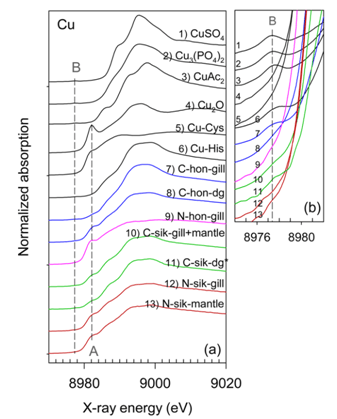作 者:Tan, Q.G., Wang, Y.,Wang, W.X. 影响因子:5.393
刊物名称:Environment. Science & Technology
出版年份:2015
卷:49 页码:6919-6925
In oysters, Cu and Zn concentration can reach extraordinarily high (1 − 2% of tissue dry weights), leading to intense green or blue colors in oyster tissues. It is thus puzzling how oysters detoxify the excessively accumulated metals. Here, we used X-ray absorption spectroscopy to examine the Cu and Zn speciation in two “colored” oysters (Crassostrea hongkongensisandCrassostrea sikameacollected from a severely metal-contaminated estuary. In contaminated oysters, we found a much higher proportion of tissue Cu and Zn as oxygen- or nitrogen-bonded species, contrasting to the sulfur-bonded (thiolate) species in normal oysters. Speciation of Cu and Zn in mantle was similar to that in gills, both of which were different from that in the digestive gland. InC.sikamea, the difference of metal speciation between normal and contaminated individuals was of similar pattern but less pronounced than that inC. hongkongensis. In normal oysters, Cu existed mainly as Cu(I) bound to sulfur, whereas in contaminated oysters mainly as Cu(II) bound to oxygen or nitrogen. Our study provided direct and semiquantitative information on the changes of metal speciation in contaminated oysters, indicating that oysters could efficiently detoxify the excessively accumulated Cu and Zn by storing them in oxygen- and nitrogen-bonded complexes in metal-rich environments.

Fig.1.(a) Normalized XANES spectra for Cu model compounds and oyster tissue samples. (b) Expanded view of the pre-edge region. C-hon = contaminatedC. hongkongensis, N-hon = normalC.hongkongensis, C-sik = contaminatedC. sikamea, N-sik = normalC.sikamea, dg = digestive gland. Feature A: signature of Cu(I); Feature B: a weak pre-edge peak indicating the presence of Cu(II). Feature B can be more easily discerned in Figure S1-b.

